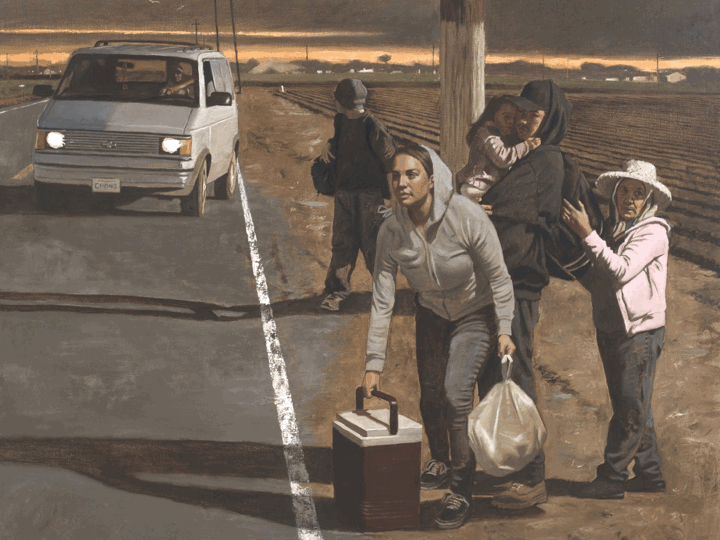Shops Open Their Doors to History : Farming: Santa Paula merchants donate space to showcase nine displays for the 15th annual Main Street Museum.
- Share via
Marian Tucker watched as volunteer historians converted the front window of her clothing store into an exhibit on apricot farming.
“As a kid, I was able to get a job pitting apricots during the harvest,” Tucker recalled of the summers she spent growing up in Santa Paula.
“Working next to my friends, we didn’t think of it as work--we thought of it as fun,” the shopkeeper said. “At least my hands didn’t get stained like the kids who shelled walnuts.”
The exhibit on the dry farming of apricots and walnuts at Tucker’s E. C. Dressing is one of nine displays on agriculture in the Santa Paula Historical Society’s 15th annual Main Street Museum, which officially opens today.
The alfresco museum, which will remain open for two weeks, utilizes storefront window space donated by nine Santa Paula merchants along a two-block stretch of Main Street.
Material for the exhibits largely comes from the society’s archives and the personal collections of its members. The donated space is a way for the small group to stretch its resources, said Janet Beach, who organized this year’s event.
“We don’t have the money, time or the means to run a permanent museum,” said Beach, a self-described newcomer who moved to Santa Paula with her husband, Edwin, in 1950. “The yearly Main Street Museum is a good alternative to a real museum.”
Along with the discovery of oil in the Santa Paula area in the 1880s, nothing has shaped the history of the town that calls itself the world’s citrus capital more than farming, Beach said in explaining the importance of this year’s show.
“I remember seeing mules still pulling plows here when I arrived in 1950,” Beach said. “And agriculture is still the economic mainstay of the area.”
As the exhibit on dry farming began to take shape recently, Mike Shore paused to give a brief rundown on the history of farming in Santa Paula. Sharp explained that only a few groves of apricot, walnut and olive trees remain from the dry-farming era, when farmers relied on the area’s scant rainfall to water their crops.
“Apricots were an important cash crop from the 1890s until World War I. While at one time there were thousands of acres of apricots, today, there are only two remaining ranches that grow them--the O’Learys in Wheeler Canyon and the Halls in the Upper Ojai.”
In 1941, the O’Learys harvested 300 tons of apricots on 93 acres and sold them for 32 cents a pound. Among the items on display are the tickets worth 50 cents each that were given to pitters like Tucker each time they filled a tray with fruit halves.
Shore said construction of the Farmer’s Ditch in the 1870s allowed farmers to plant crops that need more water.
“All the apricots and walnuts were replaced by the current crops of citrus and avocados,” said Shore, who raises citrus and avocados on 80 acres of land east of town.
Despite the success of the citrus and avocado growers, others continue to raise row crops like lima beans, lettuce and peppers, or dabble in experimental crops like persimmons, Asian pears, Fuji apples and cherimoya.
“People are always looking for another crop,” Shore said.
And a new wave of first- and second-generation Mexican-Americans has graduated from field work and joined the area’s old guard of mostly Anglo farmers, he said.
Some have leased abandoned lands or subleased other plots and introduced such new crops as cilantro, dill and rhubarb, Shore said. “They are raising crops in places where other people have given up,” he said.
All of which pretty much assures that farming will remain an important part of Santa Paula’s future as well as its past, Shore said.
More to Read
Sign up for Essential California
The most important California stories and recommendations in your inbox every morning.
You may occasionally receive promotional content from the Los Angeles Times.





![Vista, California-Apri 2, 2025-Hours after undergoing dental surgery a 9-year-old girl was found unresponsive in her home, officials are investigating what caused her death. On March 18, Silvanna Moreno was placed under anesthesia for a dental surgery at Dreamtime Dentistry, a dental facility that "strive[s] to be the premier office for sedation dentistry in Vitsa, CA. (Google Maps)](https://ca-times.brightspotcdn.com/dims4/default/07a58b2/2147483647/strip/true/crop/2016x1344+29+0/resize/840x560!/quality/75/?url=https%3A%2F%2Fcalifornia-times-brightspot.s3.amazonaws.com%2F78%2Ffd%2F9bbf9b62489fa209f9c67df2e472%2Fla-me-dreamtime-dentist-01.jpg)







